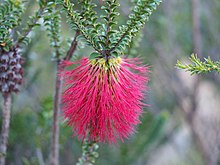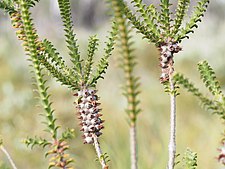| Gravel bottlebrush | |
|---|---|

| |
| Foliage and flowers of Beaufortia decussata | |
| Scientific classification | |
| Kingdom: | Plantae |
| Clade: | Tracheophytes |
| Clade: | Angiosperms |
| Clade: | Eudicots |
| Clade: | Rosids |
| Order: | Myrtales |
| Family: | Myrtaceae |
| Genus: | Beaufortia |
| Species: | B. decussata |
| Binomial name | |
| Beaufortia decussata R.Br. | |


Beaufortia decussata, commonly known as gravel bottlebrush, is a species of flowering plant in the myrtle family, Myrtaceae and is endemic to the southwest of Western Australia. It has long stems branching only near the upper ends, and scarlet to orange-red flowers in a bottlebrush shape beneath the branches.
Description
Beaufortia decussata is an erect, open shrub with few branches growing to a height of 3 m (10 ft). The leaves are arranged in alternating pairs (decussate) so that they make four rows along the stems. They are egg-shaped, pointed at the end, about 10 mm (0.4 in) long and usually have 5 veins visible.
The flowers are red to orange red and are arranged in heads about 40 mm (2 in) in diameter and 100 mm (4 in) long, forming a cylinder around the long stems under their branches. There are 5 sepals, 5 small petals and 5 bundles of stamens which give the flowers their colour and are much longer than the inconspicuous petals. Flowering occurs either from August to December or from January to April and is followed by fruit which are woody capsules. It was described in John Sims's Edwards Botanical Register as "a very splendid shrub".
Taxonomy and naming
Beaufortia decussata was the first species of Beaufortia to be described. It was formally described in 1812 by Robert Brown in William Townsend Aiton's Hortus Kewensis. The specific epithet is from the Latin decussatus meaning "form crosswise like the letter X, the Roman numeral ten".
Distribution and habitat
Beaufortia decussata occurs in the Esperance Plains, Jarrah Forest and Warren bioregions in the southwest of Western Australia, where it grows in tall shrubland in soils derived from laterite.
Conservation
Beaufortia decussata is classified as "not threatened" by the Western Australian Government Department of Biodiversity, Conservation and Attractions.
References
- "Beaufortia decussata". Australian Plant Census. Retrieved 5 October 2020.
- ^ Burbidge, Andrew A. (2016). "A taxonomic revision of Beaufortia (Myrtaceae: Melaleuceae)" (PDF). Nuytsia. 27: 179–180.
- ^ Sims, John (1815). Curtis's Botanical Magazine (Volume 42). Paternoster Row: Sherwood, Neely and Jones. p. 1733. Retrieved 19 August 2015.
- Edwards, Sydenham (1815). The Botanical Register (Volume 1). London: James Ridgway. p. 18. Retrieved 19 August 2015.
- ^ Corrick, Margaret G.; Fuhrer, Bruce A. (2009). Wildflowers of southern Western Australia (3rd ed.). Kenthurst, N.S.W.: Rosenberg Publishing. p. 112. ISBN 9781877058844. Retrieved 19 August 2015.
- ^ "Beaufortia decussata". FloraBase. Retrieved 19 August 2015.
- "Beaufortia decussata". APNI. Retrieved 19 August 2015.
- Aiton, William Townsend (1812). Hortus Kewensis. London: Longman, Hurst, Rees, Orme and Brown. p. 418. Retrieved 19 August 2015.
- Brown, Roland Wilbur (1956). The Composition of Scientific Words. Washington, D.C.: Smithsonian Institution Press. p. 239.
- Paczkowska, Grazyna; Chapman, Alex R. (2000). The Western Australian flora : a descriptive catalogue. Perth: Wildflower Society of Western Australia. p. 349. ISBN 0646402439.
| Taxon identifiers | |
|---|---|
| Beaufortia decussata | |